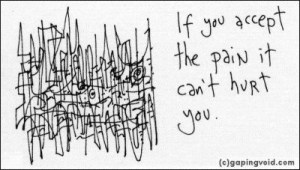
“When we cling to an identity, we create rigidity within ourselves that limits our ability to engage spontaneously with the world. We become bonded to images of ourselves that have grown out of this rigidity, and anything that threatens these images has the potential to collapse our sense of self. We fear a loss of face, a loss of self, a loss of identity. Clinging to a set identity keeps us trapped in old patterns and causes needless pain and suffering.” (Life Essentials Institute)
I’ve been dealing with a shit load of pain and suffering since June 1.
I have a mid-shaft spiral fracture of the 5th metatarsal of my left foot. I broke my foot dancing, barefoot, something that I love more than Yoga. For two weeks I was in a cast and was told to absolutely not put any weight on my foot and therefore was given crutches. Practicing trying to go up and down the bottom step of a staircase, the tip of my crutch stayed in one place and I kept going. Putting my hand out to save my foot I broke my left radius two weeks after breaking my foot. After x rays I was told if you’re going to break a wrist, mine was the “perfect fracture” to have — nothing displaced, my metacarpals still sitting perfectly atop my radius and ulna at 12 degrees.
A few days after the wrist I received a second opinion from an orthopedic surgeon on my foot. The second opinion was on foot surgery that supposedly was the “only thing” that would fix my broken bone according to the first doctor, a podiatrist. Take it from me, NEVER go to a podiatrist for anything other than cutting your toenails and even then I would think about it. At the time I had no other choice but to go to this foot doctor.
After laughing at my cast the ortho surgeon told me he NEVER casts or does surgery on a break like mine. He told his assistant to remove my cast. Like yesterday. I now wear an air boot and can walk, besides having the brace on my wrist.
The thing is, had I not had the cast I would not have had the crutches and therefore would not have fallen off my step and broke my wrist. Unfortunately, according to an attorney, my broken wrist is not large enough money- and aggravation-wise to warrant a lawsuit against the podiatrist for professional negligence.
Life changes in a second.
I have no income this summer because I can not teach. But I have lots of time to think and what I began thinking about — after the first 10 days of anxiety attacks which I never experienced before in my life coupled with deep depression — was identity.
So much came up during the first two weeks of basically being bed ridden with a cast because I was warned off walking (although I used a knee walker to get around): teaching yoga, cancelling my classes for the summer, having to cancel a weekend teacher training I was going to give, possibly cancelling my trip to India at the end of August (which is more than a personal trip, it is a tour I am being paid to do), how my body has changed, how soon can I get back to MY NORMAL LIFE.
Of course I know that a broken foot and wrist are nothing in the grand scheme of things because I…
did not lose a limb
did not suffer traumatic brain injury
did not become paralyzed
was not diagnosed with cancer or another catastrophic disease
am not going blind
and no one died.
But it still changed my life.
For moi, a very active woman of a certain age, to come to such a screeching halt, is a mind-fuck.
I thought:
WHAT THE HELL AM I DOING AND WHO THE HELL AM I?
It dawned on me:
I am not a yoga teacher, it is only what I do.
Even with all my training in India, the thousands of hours I’ve put in, If I stopped completely, never taught again, how important is all that, really? As Grace Slick used to sing, it doesn’t mean shit to a tree. Life goes on and people move on.
No standing asana but sitting and supine and lots of pranayama and meditation. And that got me thinking as it did here 7 years ago:
If you are in your 40s or 50s or 60s, why are you still doing a yoga practice as if you were in your 20s? get real. be authentic.
“I am of the nature to grow old. There is no way to escape growing old.
I am of the nature to have ill health. There is no way to escape ill health.”
I thought about all the yoga selfies out there — handstands, sick arm balances, crazy back bends, acro yoga, poses on top of a cliff during a sunrise or sunset, always looking for the newest Yoga Thing.
I don’t give a rat’s ass if I ever do another headstand or chatarunga again.
Yeah, I said that.
How does modern American yoga become someone’s identity?
Because one day you won’t be able to accomplish a handstand, an arm balance, a pretzel back bend, or maybe might not be able to walk outside to pose on a clifftop. You might not be able to even see a sunset or sunrise. Old eyes get glaucoma.
Writer and long time yoga teacher Charlotte Bell commented on this blog’s Facebook page: “Yoga was never intended to keep you from aging, getting sick or injured, or dying. Aging is not a mistake. It is written into our DNA. Anyone who thinks yoga will keep them from aging is in for a big disappointment. What yoga can do is to help us navigate reality with love and grace.”
Love and Grace. I learned long ago that I can only get that from me not from any outside source. So why am I freaking out about my so-called NORMAL LIFE being ripped away from me? That’s why the words in the first quote hit me in the gut (to paraphrase):
I became bonded to the image of myself as a dancer/yoga teacher/yoga student. My broken bones threatened those images and collapsed my sense of self. I feared a loss of face, a loss of self, a loss of identity. Clinging to a set identity kept me trapped in an old pattern and caused needless pain and suffering.
WHO ARE YOU? REALLY?
Whether you are a teacher, massage therapist, healer, paralegal, lawyer, business owner, whatever it is that you DO…
if you could not do THAT anymore, WHO ARE YOU, REALLY? You can always change that identity of what you do like you can change one blanket for another. But when you are laid bare, WHO ARE YOU?
The best thing I can do for myself right now is to take care of ME. To NOT worry about my classes or about whether my students will return after such a long hiatus or about teaching ever again. All that is not worth it because I AM WORTH SO MUCH MORE THAN ANY OF THAT.
Earlier this year a wise woman told me that 2015 will be the YEAR OF ME, that my word for 2015 is DONE, that I have put myself out there for so long for other people via learning and teaching, that now it’s my turn. I finally get it.
And whatever you do, PLEASE don’t tell me ALL THINGS HAPPEN FOR A REASON, that I broke my bones because it’s a “training.” Bullshit.
Because sometimes shit just happens.




You must be logged in to post a comment.